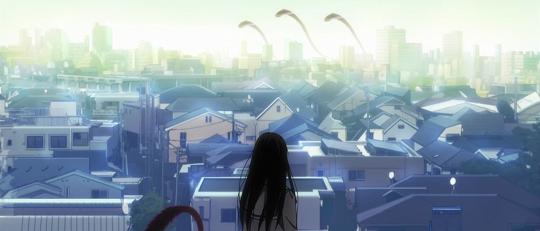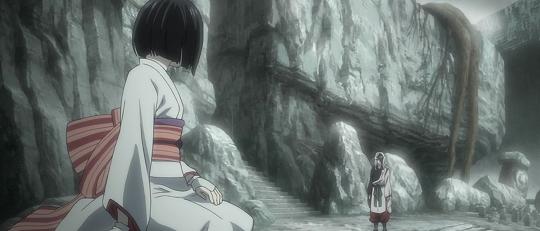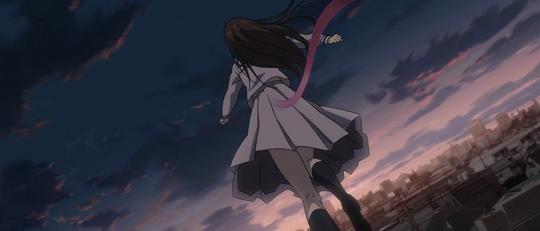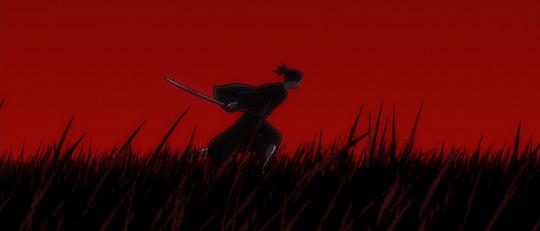We’re told repeatedly that it’s not a tail: it’s Hiyori’s lifeline to her body. Even when she makes cat ears out of shampoo foam, definitely not a tail. It’s how the opening few episodes of Noragami (Stray God) go: what you, the audience, is thinking is not what it actually is. You might think given the episodic, borderline monster-of-the-week format that episodes one through five represent the entire series. They don’t. You might start to postulate how regalia are created once Yukine makes his entrance, going as far as to assume they’re the spirits of people who have committed suicide. They’re not.
Defying its own premise and the initial evidence presented, Noragami is another example of why you don’t bet against studio Bones. Sure you get the odd dud like Darker than Black: Ryuusei no Gemini or the recent Eureka Seven: AO, but then you get gems like Un-go and yes, Noragami. At only a single season long (thus far), it is the story of Hiyori’s near-death experience and her half-in half-out status in the spirit world that introduces her to the stray god Yato and, eventually, his regalia Yukine. More subtly it’s also a story of family, understanding and sacrifice.
But back to the tail / lifeline though. Having suffered a vanishingly close brush with death, her one foot in the penumbra of the afterlife (the so-called “far shore”) allows her to detach herself from her body and go sprinting down telephone wires and from rooftop to rooftop with a grin on her face. Her body meanwhile immediately falls asleep, resulting in a kind of narcoleptic out-of-body experience. With her quirky love of wrestling on display from the outset, Hiyori is all set to become Yato’s suplexing sidekick; except something very different and subversively natural happens when the teenage Yukine arrives: she starts acting like a mother.
It starts small. A boxed lunch there, random advice here, and before you know it Yukine is sleeping only feet away from Hiyori. By association this makes the pragmatically vagrant Yato the father which, given his very literal hand in retaining Yukine, makes a peculiar kind of sense. Indeed the main and most potent story arc in the series concerns Yukine’s percolating discontent, mutating from youthful rebellion to a roar of impotent teenage fury. Just as in reality, and perhaps especially so from a Japanese cultural perspective, the sins of the children are carved into the parents, acting as a mirror and a magnifying glass for their actions. It culminates in an emotional, tear-streaked confrontation that demands a resolution and, when the darkness has lifted and the voices hoarse, it swells the heart to see and feel all of their relationships strengthen.
That idea of being from a Japanese point of view is inescapable when you’re dealing with Shinto deities. Where else but Japan could take an ancient god of poverty and cast them as a ditsy, pink-haired schoolgirl? Or the god of warfare and have them as a skin-baring busty blonde riding a lion? The underlying themes are universal but the approach is defiantly Japanese which puts the series’ final arc into some kind of context. The earlier episodes lay the mythological and emotional foundation for the final confrontation - set in an abandoned shrine deep in the mountains - and though Yukine’s ablution trucks more weight, it would not have been possible to do such a showdown without it.
Like the previous arc though, it may be surrounded by the skeins of deities but it is about something much simpler, in this case the loss of the mother to another woman. The other woman in question being the sultry jezebel, Nora, who is played as a courtesan of old: world weary and whispering discontent into the ears of all those she seduces. Her skin tattooed with the names of all those she responds to the summons of, hinting at how the concept of names is critical to many of the series’ characters. So each regalia is given two identifiers, the second playing very close to the complex Buddhist practice of posthumous names. Or even the gods themselves hiding behind other names to conceal their true identities.
It’s surprising just how rich Noragami’s world and characters are but it’s not all po-faced seriousness. There’s a goofy charm to some of the initial situations such as an impossibly extended fall from a building or the constant bickering between Hiyori and Yato or Yato and Yukine; when it wants to though, the series can dial down the light all the way to midnight black. A late stage story about a bullied highschooler is brutal in its implications, just as the tipping point for Yukine is as shocking as it is horrifying. This is not a pleasant world and we seem to be stuck in a perpetual twilight, reminded constantly of the wraiths and monsters waiting in the shadows.
All of this set to a jaw dropping soundtrack by Taku Iwasaki and with animation that can, when properly motivated, send a shiver down the spine. Perhaps the most telling part of the close of the series is how few story threads it ties off, but how little that matters. Yato’s back story was always given the lightest of touches and his historical relationship with Bishamon and one of her regalia would have required a much longer runtime to do them justice. If it weren’t for the internet I would also have been hard pressed to tell the final arc was an anime-only creation rather than straight from the source manga. Fundamentally the story that Noragami sets out to tell is captivating and emotionally complete, it doesn’t require or demand a subsequent series to fill in the gaps and it manages to stand strong on its own merits. The weak set of opening stories is about the only criticism I can justifiably level at a series that is, regardless, thoroughly engrossing and a stunning opening effort by director Kotaro Tamura.










